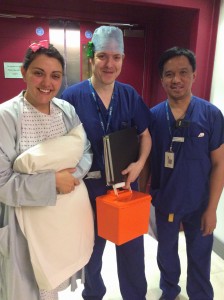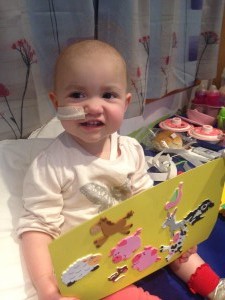
Katrina, on her way to theatre for her bone marrow to be harvested
As the voluntary donor you can feel like you call all the shots in terms of when things happen. Those arranging the donation (in my case Delete Blood Cancer UK and the Anthony Nolan Trust) know what this means to the patient’s chances so will work around and accommodate you as much as possible. That said, the more time it takes for you to be processed, the less time they have to find an alternative donor if you pull out, so you need to be honest about your level of commitment upfront.
Ultimately, it is the patient’s doctor who is in charge. The bloods, medical tests, legal papers and verbal assessments you complete are set, reviewed and approved by him. His primary concern is getting the highest quality donation from the most reliable source and ensuring the transplant is timely and ultimately, successful.
Unless you’re a familial donor then you won’t know much about the patient until about two years after the donation. However, if both sides agree, you can exchange anonymous letters before then.
When I think about the heart-breaking turmoil Yaser and Vicki went through when finding a match, I would have hated for someone to take advantage of their vulnerability at that time. The person who donated to Margot did so with the same energy I donated; with love and without condition. Not everyone in the world thinks like that, which is why the anonymity is an important protector for all concerned.
The emotional support I got from knowing Margot’s story became real to me a few weeks before my harvest (donation) when I was asked to consider donating stem cells instead of bone marrow. I knew Margot’s doctor had insisted that bone marrow was needed instead of stem cells. However, because of the anonymity, I wasn’t in a position to probe as to the reasons for the change.

Margot’s BMT doctors requested bone marrow for her as well, although this tends to happen in only around 10% of transplants
I mentioned that I tend to faint when giving blood, so you’ll understand my concerns. Donating bone marrow happens under general anaesthetic, which I’m fine with. However, you remain conscious for the stem cell procedure that lasts up to five hours and involves taking blood and using both arms. I was concerned that I’d lose my nerve, pass out too often and have to abort the donation. This would have been devastating for everyone.
Knowing about Margot’s experience of being in isolation provided me with an understanding of what might be going on in the patient’s transplant centre. I used Yaser’s recounts of that time to discuss my concerns with my own consultant at the London Clinic, which made it much easier for both of us to talk about the benefits and risks. He relayed the conversation (via the Anthony Nolan Trust) to the patient’s doctor so he could make the final decision. I signed the legal consent forms for the stem cell donation and agreed to continue with whichever procedure he considered best.
As you know, we ended up sticking to the bone marrow operation and, I’m told, it all went smoothly. It will be a while before I hear anything but I do think about how the patient and my little dozers are getting on together and hope they’re all doing well.
This is the last of my written blogs about the donation process so thanks for reading and for all of your words of encouragement. I hope this has given you an insight and made you realise that it’s really not scary or much of an inconvenience, even when you have issues with giving blood like I do!
Katrina Krishnan Doyle
Team Margot Ambassador & Donor
Husband to Vicki and father to Oscar (2007), Rufus (2008), Digby (2015), Humphrey (2017) & Margot (2012-2014)
Team Margot’s mission
To help save and improve lives by educating, inspiring and motivating people, especially from ethnically diverse communities, to register as blood, organ, stem cell and bone marrow donors and to provide a range of support to families caring for child cancer patients.
Team Margot also provides secretariat support to the All-Party Parliamentary Group for Ethnicity Transplantation and Transfusion.